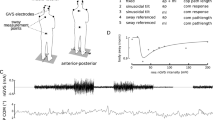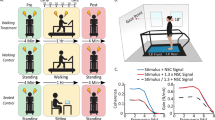Abstract
Galvanic vestibular stimulation serves to modulate the continuous firing level of the peripheral vestibular afferents. It has been shown that the application of sinusoidally varying, bipolar galvanic currents to the vestibular system can lead to sinusoidally varying postural sway. Our objective was to test the hypothesis that stochastic galvanic vestibular stimulation can lead to coherent stochastic postural sway. Bipolar binaural stochastic galvanic vestibular stimulation was applied to nine healthy young subjects. Three different stochastic vestibular stimulation signals, each with a different frequency content (0–1 Hz, 1–2 Hz, and 0–2 Hz), were used. The stimulation level (range 0.4–1.5 mA, peak to peak) was determined on an individual basis. Twenty 60-s trials were conducted on each subject – 15 stimulation trials (5 trials with each stimulation signal) and 5 control (no stimulation) trials. During the trials, subjects stood in a relaxed, upright position with their head facing forward. Postural sway was evaluated by using a force platform to measure the displacements of the center of pressure (COP) under each subject’s feet. Cross-spectral measures were used to quantify the relationship between the applied stimulus and the resulting COP time series. We found significant coherency between the stochastic vestibular stimulation signal and the resulting mediolateral COP time series in the majority of trials in 8 of the 9 subjects tested. The coherency results for each stimulation signal were reproducible from trial to trial, and the highest degree of coherency was found for the 1- to 2-Hz stochastic vestibular stimulation signal. In general, for the nine subjects tested, we did not find consistent significant coherency between the stochastic vestibular stimulation signals and the anteroposterior COP time series. This work demonstrates that, in subjects who are facing forward, bipolar binaural stochastic galvanic stimulation of the vestibular system leads to coherent stochastic mediolateral postural sway, but it does not lead to coherent stochastic anteroposterior postural sway. Our finding that the coherency was highest for the 1- to 2-Hz stochastic vestibular stimulation signal may be due to the intrinsic dynamics of the quasi-static postural control system. In particular, it may result from the effects of the vestibular stimulus simply being superimposed upon the quiet-standing COP displacements. By utilizing stochastic stimulation signals, we ensured that the subjects could not predict a change in the vestibular stimulus. Thus, our findings indicate that subjects can act as ”responders” to galvanic vestibular stimulation.
Similar content being viewed by others
Author information
Authors and Affiliations
Additional information
Received: 13 March 1998 / Accepted: 8 October 1998
Rights and permissions
About this article
Cite this article
Pavlik, A., Inglis, J., Lauk, M. et al. The effects of stochastic galvanic vestibular stimulation on human postural sway. Exp Brain Res 124, 273–280 (1999). https://doi.org/10.1007/s002210050623
Issue Date:
DOI: https://doi.org/10.1007/s002210050623




